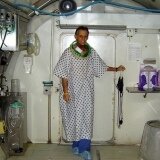Diseases Of The Respiratory System

This page briefly describes the most common injuries and diseases of the respiratory system. To see the respiratory system diagram please click here...
If you prefer to learn more about respiratory system diseases by reading a textbook, we recommend a selection of books.
Providing a detail overview of the respiratory system diseases, the recommended books selection presents the latest research in this field from around the world.
Asthma
Asthma is a condition which often lies dormant, but which is subject to attacks of respiratory distress - sometimes severe. The condition is similar in nature to an allergy. An attack may be brought on by ingesting or inhaling the triggering allergen, or by infection. Stress or emotional disturbance may lower the resistance to the allergen. An asthma attack is characterized by spasms of the smooth muscle of the bronchioles, together with a swelling of their epithelial lining, which much reduce the ability for air to pass into and - more noticeably - out of the alveoli. Lung capacity is reduced, and breathing becomes very difficult.
Asphyxia
Asphyxia is a general term inferring prevention of normal respiration. Typical causes of asphyxia include such as drowning, inhalation of poisons, and being in an Oxygen deprived atmosphere, as well as physical blockage of the airway - either internal or external.
Chronic Obstructive Pulmonary Disease (COPD)
Chronic obstructive pulmonary disease (COPD) -also known as chronic obstructive airways disease (COAD) - is a general term covering several diseases of the respiratory system which affect the respiratory tract, and which are generally long term in nature.
Bronchitis
Bronchitis is an inflammation of the mucous membrane in the bronchi. It takes two forms - acute and chronic. The acute form is caused by bacterial infection and tends to follow other respiratory infections. It usually results in a reduction of the lumen of the bronchi and bronchioles, production of heavy clogging mucus a with debilitating cough, and respiratory difficulty.
In chronic bronchitis, mucus builds up in the lungs, reducing the ability for gas exchange. This leads to a lower blood Oxygen and higher blood Carbon Dioxide. Over time, the body adjusts to the higher Carbon Dioxide level, and the respiratory centre loses full control. Breathing is then triggered solely by a low Oxygen level, rather than a high Carbon Dioxide level. This reliance on a low Oxygen level for respiratory control is known as the hypoxic drive. Permanent cyanosis may be present. Chronic bronchitis may follow acute bronchitis, or may result from long term heavy smoking or long term exposure to atmospheric pollutants.
Emphysema
The term emphysema is generally used to indicate a respiratory disease where degenerative changes occur in the tissue of the bronchioles, alveolar ducts, and alveoli. It literally means "air in the tissues". Emphysema leads to a loss of elasticity and a breakdown of the bronchiole and alveolar walls. The alveoli become less effective, and the loss of elasticity causes entrapment of air within the lungs. Exhalation is thus made much more difficult and may require considerable muscular action. The condition may be caused by long term heavy smoking, or it may lead on from bronchitis or other respiratory diseases. Emphysema may be aggravated by frequent coughing which damages the air tract walls.
Pneumonia
Pneumonia is an inflammation of the smallest bronchioles and alveoli in one, or both, lungs. The most common cause is infection - usually bacterial, but also viral. Pneumonia is also a potential complication resulting from a lowered cough reflex through muscle or nerve damage, long term heavy smoking, inhalation of pollutants, or other pulmonary infections or diseases. The inflammation reduces the ability for gas exchange with a consequent reduction in respiratory effectiveness, together with coughing and breathlessness. As neutrophils attack the infection, fluid builds up in the alveoli, further complicating the condition.
Common Cold
In illnesses such as the common cold, viruses invade the mucous membranes of the nose and pharynx. If the immune system does not immediately destroy them, the viruses multiply. As lymphocytes attack the viruses, slight tissue oedema results and there is excessive mucus production. These lead to the classic signs and symptoms of such infections. The common cold (coryzal, or viral rhinitis) is a generally mild viral infection affecting the upper respiratory tracts. Usually, the condition causes no more than irritation to the throat and pharynx, a runny nose, sneezing, and nasal discomfort, although a slightly elevated temperature and headache may also occur.
Croup
Croup is the term given to several different diseases of the respiratory system (including laryngo tracheo bronchitis, laryngismus stridulosus and acute laryngitis) which affect the upper airway in young children of up to four years age. Croup tends to begin suddenly, often at night. It produces fever, with swelling and congestion of the upper airway leading to respiratory distress and noisy breathing. A barking cough (often likened to a seal bark) is a characteristic sign.
Cystic Fibrosis
Cystic fibrosis is an inherited disease affecting the mucous and sweat glands. Thick mucous forms in the lungs, causing respiratory problems and encouraging infection. The condition also disturbs pancreatic enzyme production and prevents proper absorption of fats, leading to nutritional problems. Continual treatment is required. Even with this, the expected lifespan is unlikely to exceed 30 years.
Decompression Sickness
Decompression sickness, the bends, or caisson disease, occurs when the body is moved from an area of high external pressure to an area of lower pressure, such as when a diver surfaces from a deep dive. A small amount of Nitrogen gas dissolves into the blood from inhaled air. The amount of dissolved Nitrogen is higher for a higher external pressure. During the change to lower external pressure, some Nitrogen will come out of solution. A slow change of pressure will allow this to occur in the lungs, with the Nitrogen being exhaled. A rapid change of pressure, however, will cause Nitrogen to form gas bubbles inside the blood vessels. This leads to severe pain in the joints, limbs, and abdomen, together with a headache, dizziness and sometimes paralysis. In extreme cases, the condition may prove fatal.
Drowning
Drowning is a specific cause of asphyxia, resulting from the immersion of the mouth and nose in liquid - usually water - thus preventing the intake of air.
Sudden immersion in cold water and the realisation of danger often causes sharp intakes of breath. As water is taken into the mouth, considerable amounts will be swallowed, reducing buoyancy and compounding the problem. (Read more about Drowning...)
Epiglottitis
Epiglottitis is a dangerous infection of the epiglottis by haemophilus influenzae bacteria. It mainly affects children of three to seven years age. Onset is acute with a high fever, severe pain on swallowing, and a hoarse brassy cough. Respiratory distress may cause the sufferer to sit upright, leaning forward with the chin thrust out in order to ease breathing.
Haemothorax
A haemothorax results when blood escapes into the pleural space from damaged blood vessels. This applies pressure to a lung, and impairs respiration.
Influenza
Influenza is a viral infection of the respiratory system. There are many different strains, leading to a wide variation in signs and symptoms. The condition usually begins rapidly, with chills, fever, headache, and aches in the back, limbs and joints. As the condition continues, weakness, fatigue, sweating, a dry cough and respiratory difficulties may develop. Several weeks of fatigue and depression may follow on from recovery of the main infection.
Pleurisy
Among other diseases of the respiratory system Pleurisy is a painful inflammation of the pleura, caused usually by infection, although it may lead on from, or accompany, diseases of the respiratory system such as pneumonia, tuberculosis, lung tumours, or influenza. There are two forms of pleurisy:
- Dry pleurisy. This is a straightforward inflammation of the pleura.
- Wet pleurisy. This is an inflammation of the pleura causing release of fluid into the pleural cavity.
Pneumoconiosis
Pneumoconiosis is the term used for a variety of chronic inflammatory diseases of the respiratory system caused by long term inhalation of solid contaminants. Individual diseases tends to be named according to the causing agent:
- Silicosis caused by inhaling silica dust.
- Anthracosis caused by inhaling coal dust.
- Asbestosis caused by inhaling asbestos dust.
- Byssinosis caused by inhaling textile fibres.
- Farmers lung caused by inhaling dust from hay or straw.
Contaminating particles enter the alveoli, where they are ingested by macrophages, but not destroyed. The macrophages then die, releasing the original particles and agents which lead to the growth of fibrous tissue.
This process repeats many times, building up more and more fibrous tissue and eventually reducing the effectiveness of the lungs below that of normal respiratory requirements. Increasing breathlessness and a chronic cough are common symptoms. Pneumoconiosis may also lead on to pneumonia, tuberculosis, or lung cancer.
Pneumothorax
A pneumothorax occurs when air enters the pleural space. This then prevents the correct inflation of the associated lung, and may exert pressure on the heart, leading to serious problems. The air may enter the pleural space either through an abnormal opening in the chest wall, or from a damaged lung (or a combination of both).
Closed pneumothorax. This occurs when the outer chest wall is intact, or where an abnormal opening has been sealed. This may occur through injury, or may occur spontaneously - more commonly in tall, thin, young men.
Open pneumothorax. This occurs when an opening is made in the chest wall. Air may be sucked in through the opening on inhalation, and blown out on exhalation. The accompanying wound is often termed a sucking wound.
Tension pneumothorax. This highly dangerous condition is caused when a one-way valve is created by a flap of damaged lung tissue. Air passes into the pleural space on exhalation, but is not drawn from it on inhalation. The air pressure in the pleural space thus builds up, applying increasing pressure to the injured lung, and eventually to the other lung and the heart. As the air pressure in the pleural space increases, the lung on the affected side may well collapse.
Pulmonary Contusion
Pulmonary contusion often accompanies other serious chest injuries. Physical damage to the lungs allows blood into the interstitial spaces and alveoli, and the basic mechanism of respiratory gas exchange is impeded.
Pulmonary Embolism
A pulmonary embolism is a blockage in a pulmonary artery, usually caused by a blood clot - perhaps originating from a deep vein thrombosis in a leg. The condition reduces respiratory effectiveness and may mimic a myocardial infarction, with acute and severe chest pain, and breathlessness.
Pulmonary Oedema
Pulmonary oedema is a condition where fluid enters the alveoli and interstitial spaces from the pulmonary circulation, causing extreme respiratory distress. A common cause is left ventricular failure as a side effect of a myocardial infarction. Other causes include hypertension, disease of the mitral or aortic valves, other infections, drowning, or the inhalation of poisons.
Rib Fractures
Rib fractures tend to affect the front of the middle ribs, as these are long, thin, and poorly protected. A simple rib fracture is rarely a serious injury, as the intercostal muscles retain the position of the fractured bone.
Flail chest
If three or more adjacent ribs are fractured in more than one place, a segment of the ribcage loses its integrity, and a loose section or flail section of chest wall will result, although the intercostal muscles may maintain some support for a time. As it is not connected to the main body of the ribcage, the flail section does not move properly with the muscular action of respiration, but moves to follow differences in air pressure. This leads to paradoxical movement, where the flail segment moves inwards during inhalation, and outwards during exhalation.
Tuberculosis
Tuberculosis is an infection by mycobacterium tuberculosis bacteria. The condition most frequently manifests itself in the lungs (pulmonary tuberculosis - previously known as consumption), although it can affect tissues throughout the body. It is spread in sputum. It is also carried by cattle and spread in unpasturised milk. Bacteria inhaled into the lungs cause lesions, known as tubercules, in the lung tissue. These may spread to nearby lymph nodes. At this stage, the immune system may fight off the infection, or it may lie dormant, to attack at some later time. The onset of the disease is slow and begins with a cough. Bloodstained sputum, severe fatigue, loss of appetite and weight, fever, and night sweats all then develop and worsen as the disease takes hold. Untreated tuberculosis is eventually fatal.
Return from Diseases Of The Respiratory System to the Home Page
Return from Diseases Of The Respiratory System to the Hyperbaric Oxygen Therapy Overview












